ACC515 Corporate Finance: Comprehensive Financial Analysis Report
VerifiedAdded on 2022/08/27
|9
|714
|41
Report
AI Summary
This report provides a detailed analysis of corporate finance concepts, including capital budgeting, investment analysis, and valuation techniques. It examines key financial metrics such as Net Present Value (NPV), Profitability Index (PI), and Payback Period to evaluate project feasibility. The analysis includes calculations of the Value of Debt, Cost of Debt, Value of Ordinary Shares, Cost of Preference Shares, and Cost of Equity using different models like the Dividend Discount Model (DDM). The report also calculates the Weighted Average Cost of Capital (WACC) and discusses the impact of changes in the cost of capital on firm value. The report concludes with an examination of mutually exclusive projects and the application of financial tools to make informed investment decisions. The report is a comprehensive overview of financial analysis and decision-making in a corporate setting.

Running head: CORPORATE FINANCE
Corporate Finance
Name of the Student:
Name of the University:
Author’s Note:
Corporate Finance
Name of the Student:
Name of the University:
Author’s Note:
Paraphrase This Document
Need a fresh take? Get an instant paraphrase of this document with our AI Paraphraser
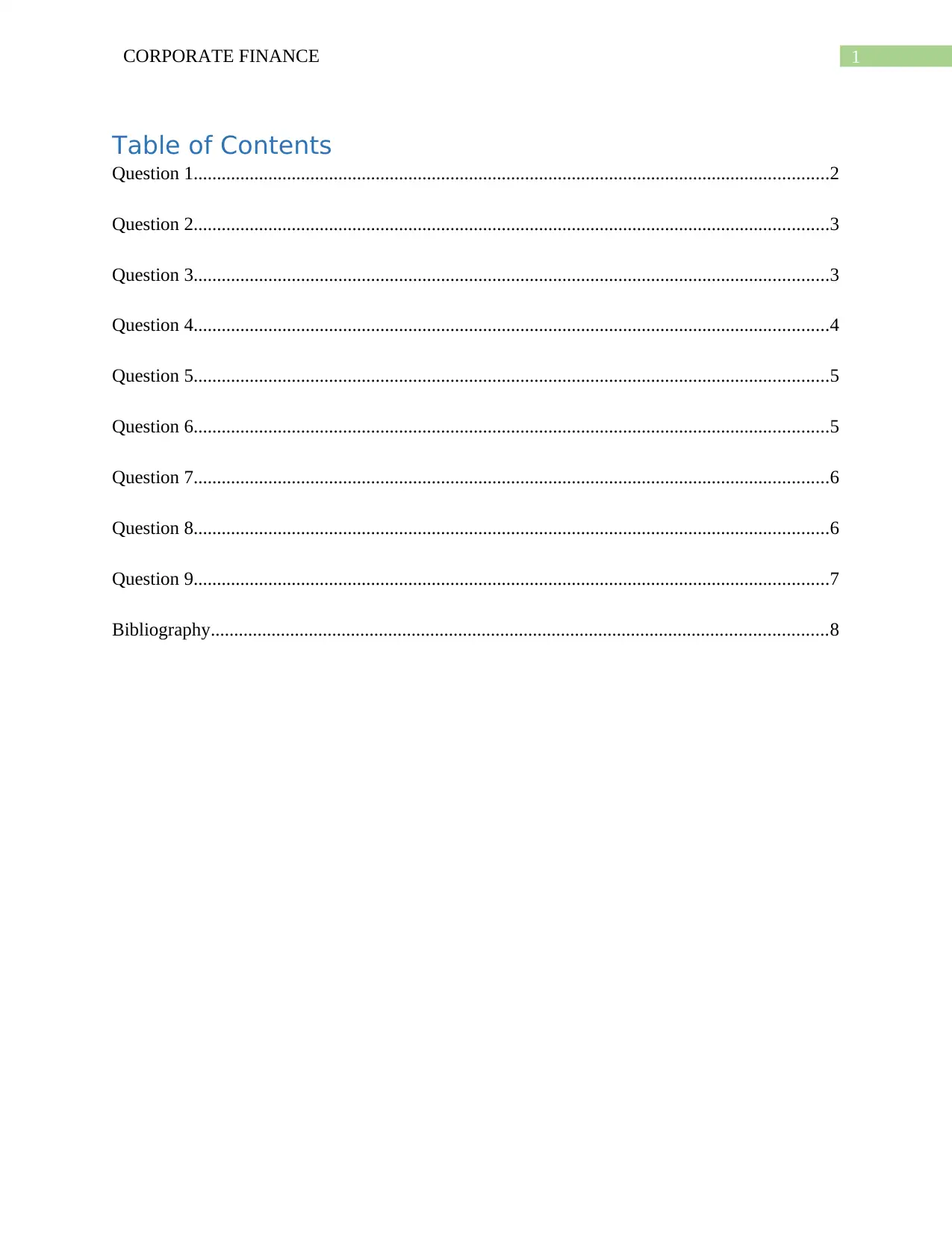
1CORPORATE FINANCE
Table of Contents
Question 1........................................................................................................................................2
Question 2........................................................................................................................................3
Question 3........................................................................................................................................3
Question 4........................................................................................................................................4
Question 5........................................................................................................................................5
Question 6........................................................................................................................................5
Question 7........................................................................................................................................6
Question 8........................................................................................................................................6
Question 9........................................................................................................................................7
Bibliography....................................................................................................................................8
Table of Contents
Question 1........................................................................................................................................2
Question 2........................................................................................................................................3
Question 3........................................................................................................................................3
Question 4........................................................................................................................................4
Question 5........................................................................................................................................5
Question 6........................................................................................................................................5
Question 7........................................................................................................................................6
Question 8........................................................................................................................................6
Question 9........................................................................................................................................7
Bibliography....................................................................................................................................8
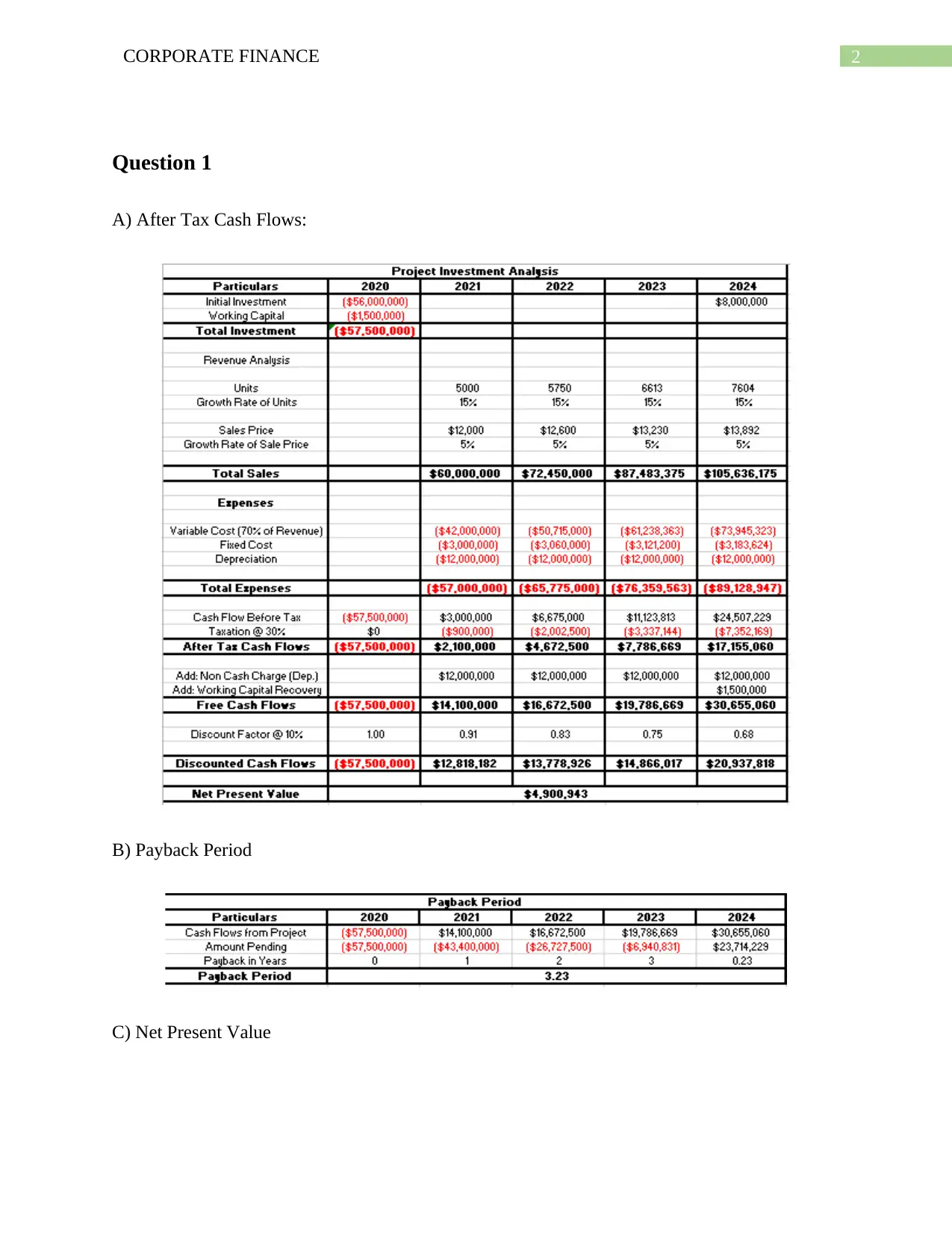
2CORPORATE FINANCE
Question 1
A) After Tax Cash Flows:
B) Payback Period
C) Net Present Value
Question 1
A) After Tax Cash Flows:
B) Payback Period
C) Net Present Value
⊘ This is a preview!⊘
Do you want full access?
Subscribe today to unlock all pages.

Trusted by 1+ million students worldwide
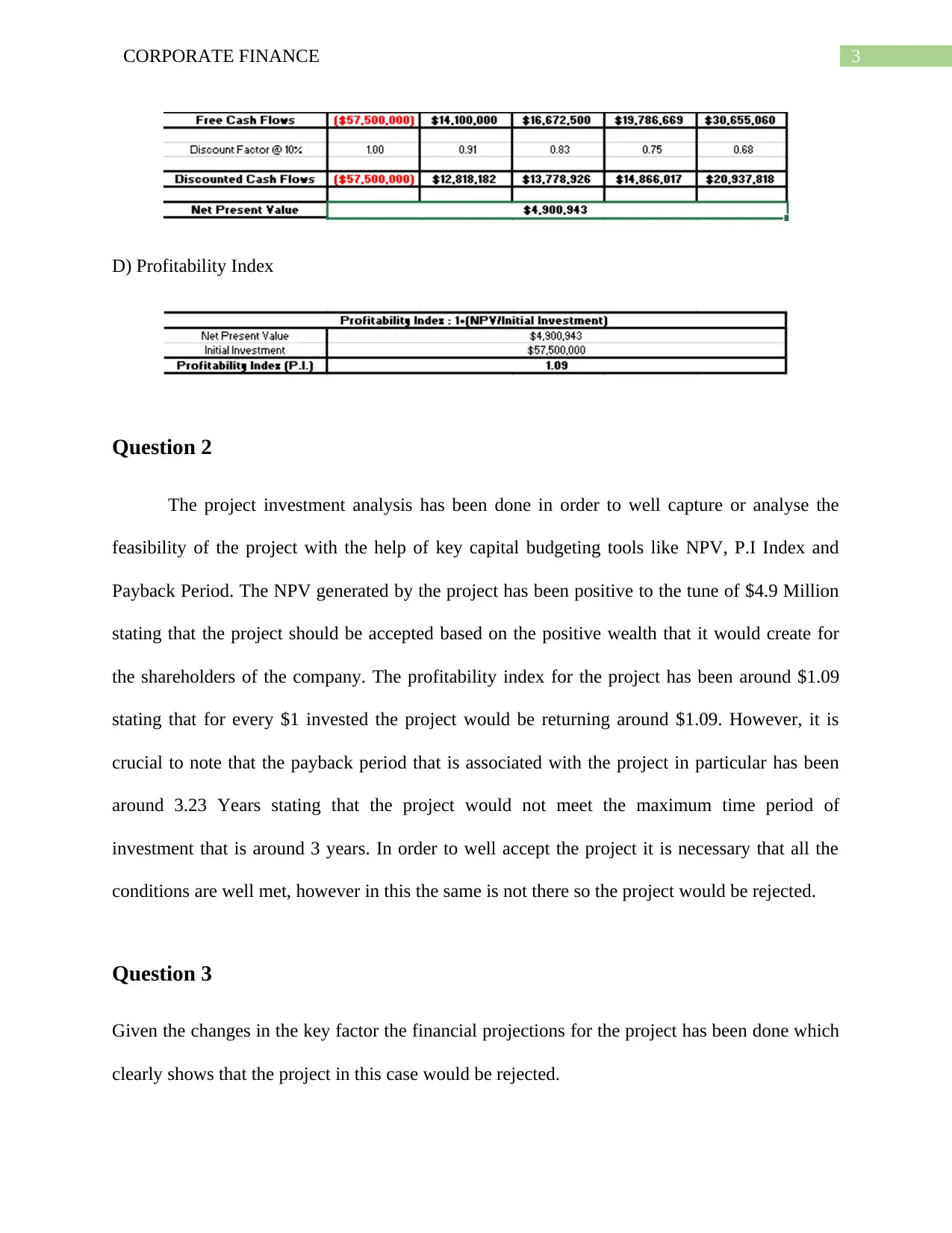
3CORPORATE FINANCE
D) Profitability Index
Question 2
The project investment analysis has been done in order to well capture or analyse the
feasibility of the project with the help of key capital budgeting tools like NPV, P.I Index and
Payback Period. The NPV generated by the project has been positive to the tune of $4.9 Million
stating that the project should be accepted based on the positive wealth that it would create for
the shareholders of the company. The profitability index for the project has been around $1.09
stating that for every $1 invested the project would be returning around $1.09. However, it is
crucial to note that the payback period that is associated with the project in particular has been
around 3.23 Years stating that the project would not meet the maximum time period of
investment that is around 3 years. In order to well accept the project it is necessary that all the
conditions are well met, however in this the same is not there so the project would be rejected.
Question 3
Given the changes in the key factor the financial projections for the project has been done which
clearly shows that the project in this case would be rejected.
D) Profitability Index
Question 2
The project investment analysis has been done in order to well capture or analyse the
feasibility of the project with the help of key capital budgeting tools like NPV, P.I Index and
Payback Period. The NPV generated by the project has been positive to the tune of $4.9 Million
stating that the project should be accepted based on the positive wealth that it would create for
the shareholders of the company. The profitability index for the project has been around $1.09
stating that for every $1 invested the project would be returning around $1.09. However, it is
crucial to note that the payback period that is associated with the project in particular has been
around 3.23 Years stating that the project would not meet the maximum time period of
investment that is around 3 years. In order to well accept the project it is necessary that all the
conditions are well met, however in this the same is not there so the project would be rejected.
Question 3
Given the changes in the key factor the financial projections for the project has been done which
clearly shows that the project in this case would be rejected.
Paraphrase This Document
Need a fresh take? Get an instant paraphrase of this document with our AI Paraphraser
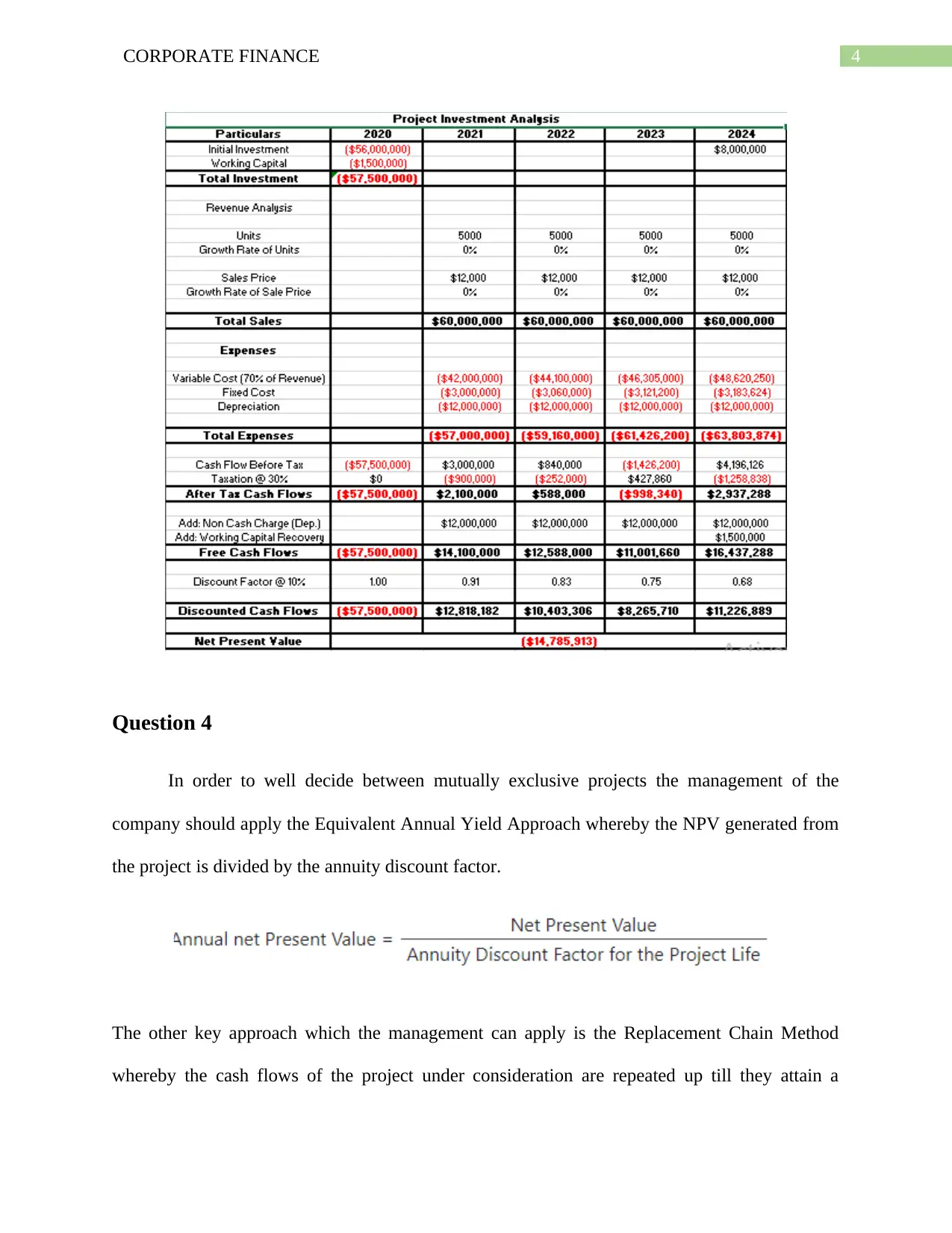
4CORPORATE FINANCE
Question 4
In order to well decide between mutually exclusive projects the management of the
company should apply the Equivalent Annual Yield Approach whereby the NPV generated from
the project is divided by the annuity discount factor.
The other key approach which the management can apply is the Replacement Chain Method
whereby the cash flows of the project under consideration are repeated up till they attain a
Question 4
In order to well decide between mutually exclusive projects the management of the
company should apply the Equivalent Annual Yield Approach whereby the NPV generated from
the project is divided by the annuity discount factor.
The other key approach which the management can apply is the Replacement Chain Method
whereby the cash flows of the project under consideration are repeated up till they attain a
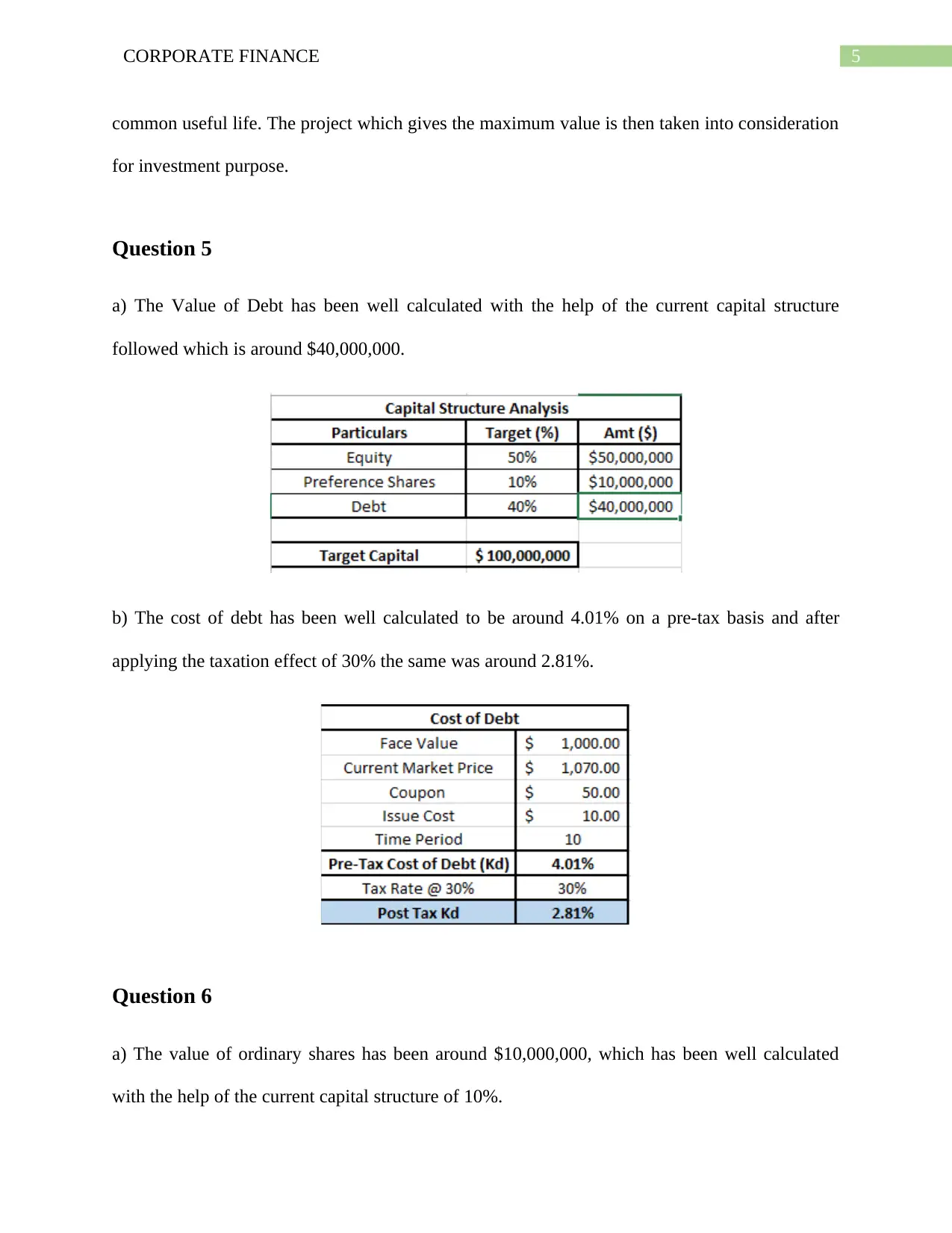
5CORPORATE FINANCE
common useful life. The project which gives the maximum value is then taken into consideration
for investment purpose.
Question 5
a) The Value of Debt has been well calculated with the help of the current capital structure
followed which is around $40,000,000.
b) The cost of debt has been well calculated to be around 4.01% on a pre-tax basis and after
applying the taxation effect of 30% the same was around 2.81%.
Question 6
a) The value of ordinary shares has been around $10,000,000, which has been well calculated
with the help of the current capital structure of 10%.
common useful life. The project which gives the maximum value is then taken into consideration
for investment purpose.
Question 5
a) The Value of Debt has been well calculated with the help of the current capital structure
followed which is around $40,000,000.
b) The cost of debt has been well calculated to be around 4.01% on a pre-tax basis and after
applying the taxation effect of 30% the same was around 2.81%.
Question 6
a) The value of ordinary shares has been around $10,000,000, which has been well calculated
with the help of the current capital structure of 10%.
⊘ This is a preview!⊘
Do you want full access?
Subscribe today to unlock all pages.

Trusted by 1+ million students worldwide
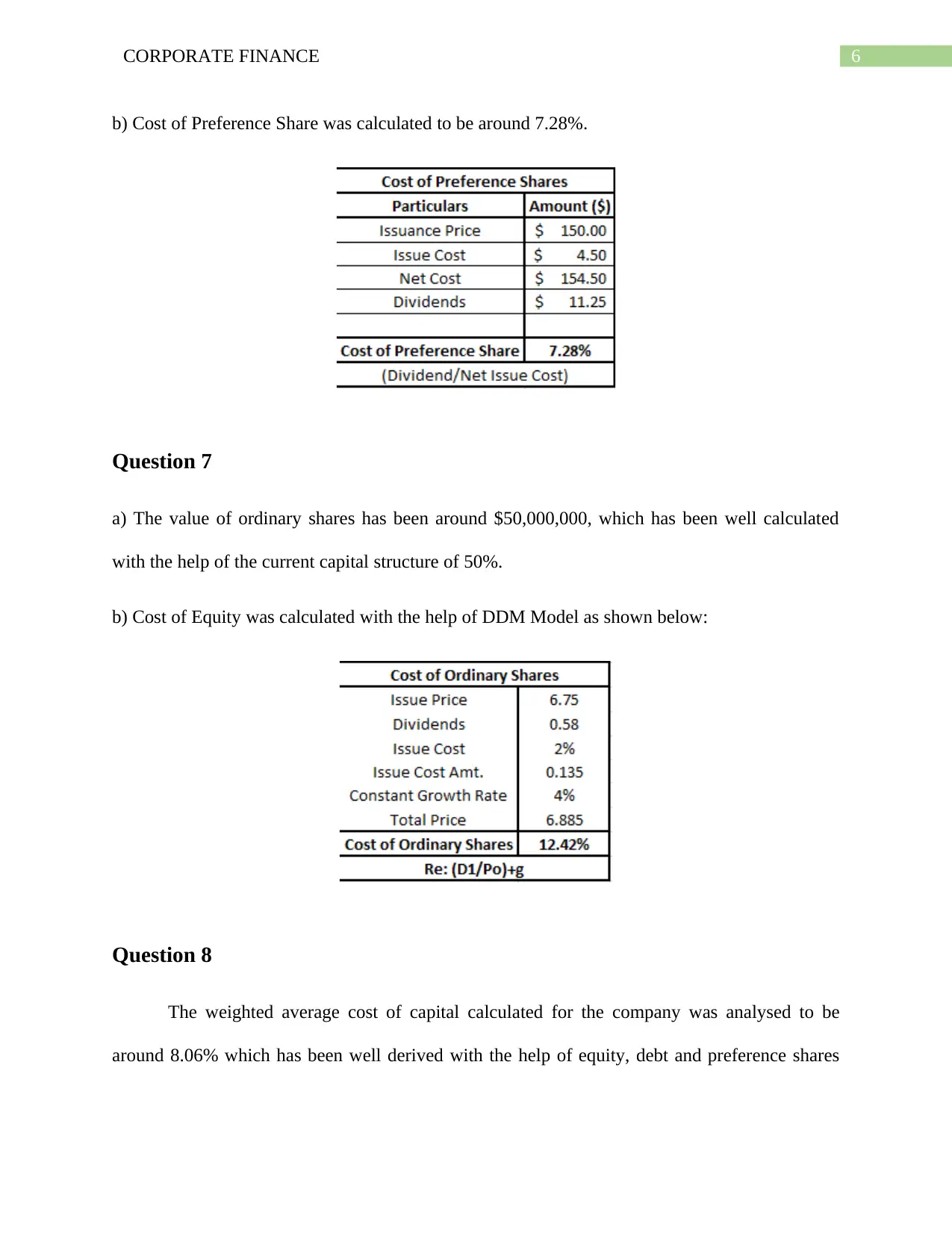
6CORPORATE FINANCE
b) Cost of Preference Share was calculated to be around 7.28%.
Question 7
a) The value of ordinary shares has been around $50,000,000, which has been well calculated
with the help of the current capital structure of 50%.
b) Cost of Equity was calculated with the help of DDM Model as shown below:
Question 8
The weighted average cost of capital calculated for the company was analysed to be
around 8.06% which has been well derived with the help of equity, debt and preference shares
b) Cost of Preference Share was calculated to be around 7.28%.
Question 7
a) The value of ordinary shares has been around $50,000,000, which has been well calculated
with the help of the current capital structure of 50%.
b) Cost of Equity was calculated with the help of DDM Model as shown below:
Question 8
The weighted average cost of capital calculated for the company was analysed to be
around 8.06% which has been well derived with the help of equity, debt and preference shares
Paraphrase This Document
Need a fresh take? Get an instant paraphrase of this document with our AI Paraphraser
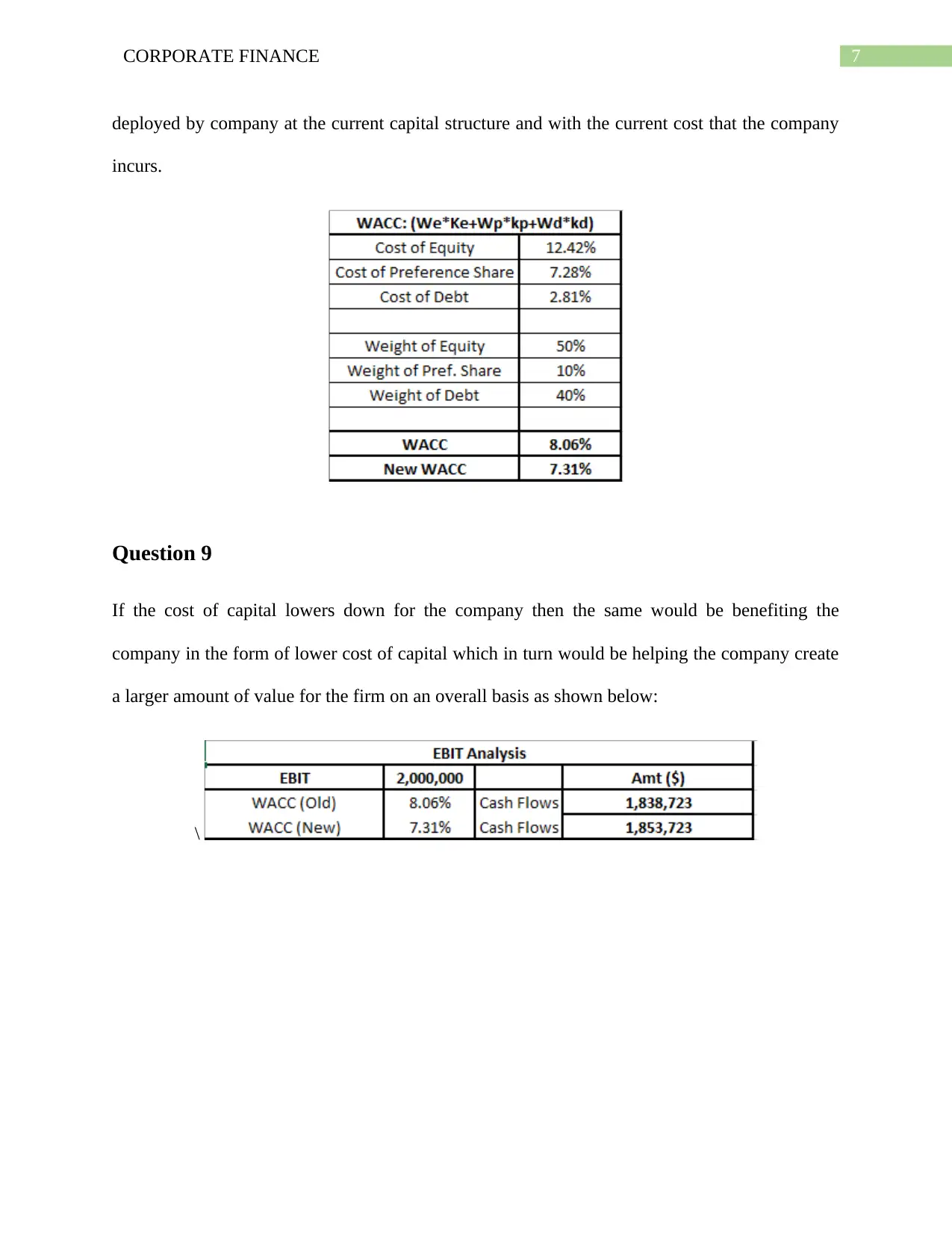
7CORPORATE FINANCE
deployed by company at the current capital structure and with the current cost that the company
incurs.
Question 9
If the cost of capital lowers down for the company then the same would be benefiting the
company in the form of lower cost of capital which in turn would be helping the company create
a larger amount of value for the firm on an overall basis as shown below:
\
deployed by company at the current capital structure and with the current cost that the company
incurs.
Question 9
If the cost of capital lowers down for the company then the same would be benefiting the
company in the form of lower cost of capital which in turn would be helping the company create
a larger amount of value for the firm on an overall basis as shown below:
\
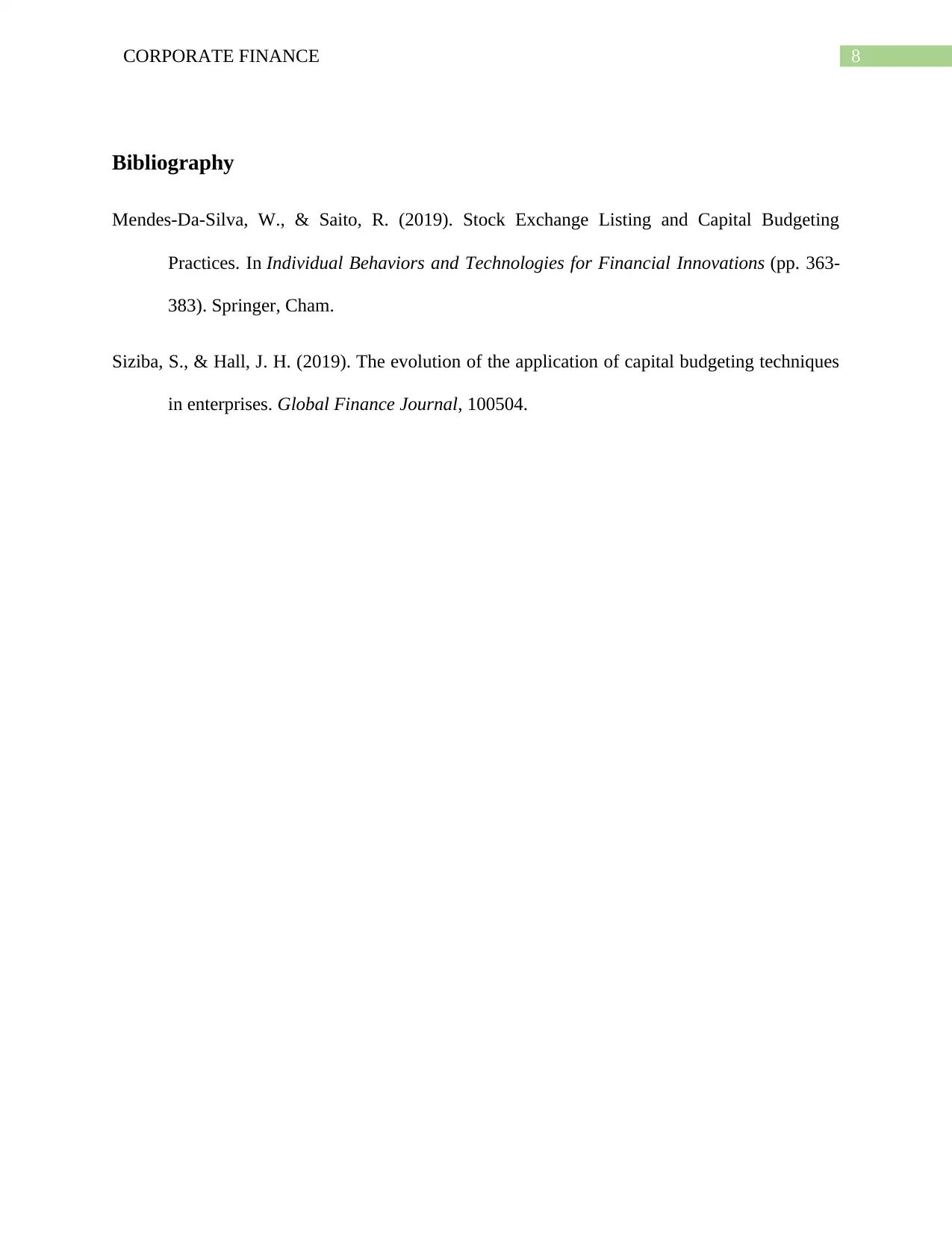
8CORPORATE FINANCE
Bibliography
Mendes-Da-Silva, W., & Saito, R. (2019). Stock Exchange Listing and Capital Budgeting
Practices. In Individual Behaviors and Technologies for Financial Innovations (pp. 363-
383). Springer, Cham.
Siziba, S., & Hall, J. H. (2019). The evolution of the application of capital budgeting techniques
in enterprises. Global Finance Journal, 100504.
Bibliography
Mendes-Da-Silva, W., & Saito, R. (2019). Stock Exchange Listing and Capital Budgeting
Practices. In Individual Behaviors and Technologies for Financial Innovations (pp. 363-
383). Springer, Cham.
Siziba, S., & Hall, J. H. (2019). The evolution of the application of capital budgeting techniques
in enterprises. Global Finance Journal, 100504.
⊘ This is a preview!⊘
Do you want full access?
Subscribe today to unlock all pages.

Trusted by 1+ million students worldwide
1 out of 9
Related Documents
Your All-in-One AI-Powered Toolkit for Academic Success.
+13062052269
info@desklib.com
Available 24*7 on WhatsApp / Email
![[object Object]](/_next/static/media/star-bottom.7253800d.svg)
Unlock your academic potential
Copyright © 2020–2025 A2Z Services. All Rights Reserved. Developed and managed by ZUCOL.





